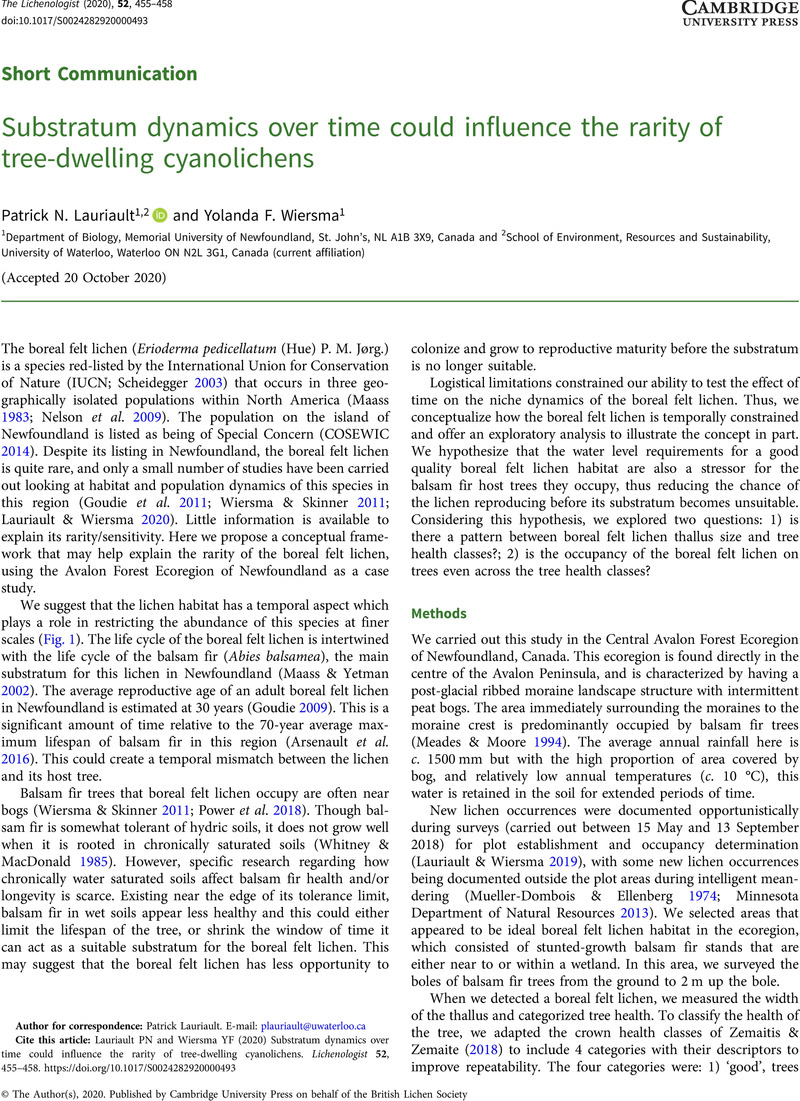No CrossRef data available.
Article contents
Substratum dynamics over time could influence the rarity of tree-dwelling cyanolichens
Published online by Cambridge University Press: 20 January 2021
Abstract
An abstract is not available for this content so a preview has been provided. Please use the Get access link above for information on how to access this content.

Information
- Type
- Short Communication
- Information
- Copyright
- Copyright © The Author(s), 2020. Published by Cambridge University Press on behalf of the British Lichen Society
References
Arsenault, A, LeBlanc, R, Earle, E, Brooks, D, Clarke, B, Lavigne, D and Royer, L (2016) Unravelling the past to manage Newfoundland's forests for the future. The Forestry Chronicle 92, 487–502.CrossRefGoogle Scholar
Cameron, RP and Richardson, DHS (2006) Occurrence and abundance of epiphytic cyanolichens in protected areas of Nova Scotia, Canada. Opuscula Philolichenum 3, 5–14.Google Scholar
Campbell, J, Bradfield, GE, Prescott, CE and Fredeen, AL (2010) The influence of overstorey Populus on epiphytic lichens in subboreal spruce forests of British Columbia. Canadian Journal of Forest Research 40, 143–154.CrossRefGoogle Scholar
Cornejo, C and Scheidegger, C (2016) Cyanobacterial gardens: the liverwort Frullania asagrayana acts as a reservoir of lichen photobionts. Environmental Microbiology Reports 8, 352–357.CrossRefGoogle ScholarPubMed
COSEWIC (2014) COSEWIC assessment and status report on the boreal felt lichen Erioderma pedicellatum, Boreal population and Atlantic population, in Canada. Ottawa: Committee on the Status of Endangered Wildlife in Canada.Google Scholar
Dale, VH, Joyce, LA, McNulty, S, Nelson, RP, Ayres, MP, Flannigan, MD, Hanson, PJ, Irland, LC, Lugo, AE, Peterson, CJ, et al. (2001) Climate change and forest disturbances. BioScience 51, 723–734.CrossRefGoogle Scholar
Gauslaa, Y (2014) Rain, dew, and humid air as drivers of morphology, function and spatial distribution in epiphytic lichens. Lichenologist 46, 1–16.CrossRefGoogle Scholar
Gosse, J, Hermanutz, L, McLaren, B, Deering, P and Knight, T (2011) Degradation of boreal forests by non-native herbivores in Newfoundland's national parks: recommendations for ecosystem restoration. Natural Areas Journal 31, 331–339.CrossRefGoogle Scholar
Goudie, I (2009) Compendium of studies of the boreal felt lichen (Erioderma pedicellatum) funded by Vale Inco Newfoundland and Labrador Limited in Eastern Newfoundland, 2005 to 2008. LGL Report No. SA992/SA1003 Supplement. Prepared for Vale Inco Newfoundland and Labrador Limited, St. John's, Newfoundland.Google Scholar
Goudie, RI, Scheidegger, C, Hanel, C, Munier, A and Conway, E (2011) New population models help explain declines in the globally rare boreal felt lichen Erioderma pedicellatum in Newfoundland. Endangered Species Research 13, 181–189.CrossRefGoogle Scholar
Lauriault, P and Wiersma, YF (2019) Reducing the rates of false absences of cryptic species in inventory and sampling work. Bryologist 122, 578–585.CrossRefGoogle Scholar
Lauriault, P and Wiersma, YF (2020) Identifying important characteristics for critical habitat of boreal felt lichen (Erioderma pedicellatum) in Newfoundland, Canada. Bryologist 123, 412–420.CrossRefGoogle Scholar
Maass, WSG (1983) New observations on Erioderma in North America. Nordic Journal of Botany 3, 567–576.CrossRefGoogle Scholar
Maass, WSG and Yetman, D (2002) COSEWIC assessment and status report on the boreal felt lichen (Erioderma pedicellatum) in Canada. Ottawa: Committee on the Status of Endangered Wildlife in Canada.Google Scholar
Meades, WJ and Moore, L (1994) Forest site classification manual. A guide to the Damman forest types of Newfoundland, 2nd edn. Forest Resource Development Agreement Report 003. Corner Brook, Newfoundland: Western Newfoundland Model Forest Inc.Google Scholar
Minnesota Department of Natural Resources (2013) Handbook for Collecting Vegetation Plot Data in Minnesota: the Relevé Method, 2nd edn. Minnesota Biological Survey, Minnesota Natural Heritage and Nongame Research Program, and Ecological Land Classification Program. Biological Report 92. St. Paul: Minnesota Department of Natural Resources.Google Scholar
Mueller-Dombois, D and Ellenberg, H (1974) Aims and Methods of Vegetation Ecology. New York: John Wiley & Sons.Google Scholar
Nelson, P, Walton, J and Roland, C (2009) Erioderma pedicellatum (Hue) P. M. Jørg., new to the United States and western North America, discovered in Denali National Park and Preserve and Denali State Park, Alaska. Evansia 26, 19–23.Google Scholar
Power, TD, Cameron, RP, Neily, T and Toms, B (2018) Forest structure and site conditions of boreal felt lichen (Erioderma pedicellatum) habitat in Cape Breton, Nova Scotia, Canada. Botany 96, 449–459.CrossRefGoogle Scholar
R Core Team (2019) R: a Language and Environment for Statistical Computing. R Foundation for Statistical Computing, Vienna, Austria. [WWW resource] URL http://www.r-project.org/.Google Scholar
Rodriguez-Gonzalez, PM, Stella, JC, Campelo, F, Ferreira, MT and Albuquerque, A (2010) Subsidy or stress? Tree structure growth in wetland forests along hydrological gradient in Southern Europe. Forest Ecology and Management 259, 2015–2025.CrossRefGoogle Scholar
Scheidegger, C (Lichen Specialist Group) (2003) Erioderma pedicellatum. The IUCN Red List of Threatened Species 2003. e.T43995A10839336. [WWW resource] URL http://dx.doi.org/10.2305/IUCN.UK.2003.RLTS.T43995A10839336.enCrossRefGoogle Scholar
Scheidegger, C and Werth, S (2009) Conservation strategies for lichens: insights from population biology. Fungal Biology Reviews 23, 55–66.CrossRefGoogle Scholar
Solomon, DS, Zhang, L, Brann, TB and Larrick, DS (2003) Mortality patterns following spruce budworm infestation in unprotected spruce-fir forests in Maine. Northern Journal of Applied Forestry 20, 148–153.CrossRefGoogle Scholar
Tagirdzhanova, G, Stepanchikova, IS, Himelbrant, DE, Vyatkina, MP, Dyomina, AV, Dirksen, VG and Scheidegger, C (2019) Distribution and assessment of the conservation status of Erioderma pedicellatum in Asia. Lichenologist 51, 575–585.CrossRefGoogle Scholar
Whitney, RD and MacDonald, GB (1985) Effects of root rot on the growth of balsam fir. Canadian Journal of Forest Research 15, 890–895.CrossRefGoogle Scholar
Wiersma, YF and Skinner, R (2011) Predictive distribution model for the boreal felt lichen Erioderma pedicellatum in Newfoundland, Canada. Endangered Species Research 15, 115–127.CrossRefGoogle Scholar
Wigle, RD, Wiersma, YF, Arsenault, A, McMullin, RT (2020) Drivers of arboreal lichen community structure and diversity across scales. Botany. DOI: 10.1139/cjb-2020-0061CrossRefGoogle Scholar
Zemaitis, P and Zemaite, I (2018) Does butt rot affect the crown condition of Norway spruce trees? Trees 32, 489–495.CrossRefGoogle Scholar


